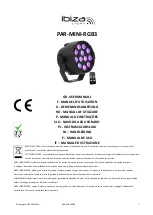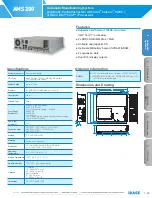
BASIC OPERATION
DESCRIPTION OF HOIST
The PD21A hoist is made up of the following sub-
assemblies:
1. Hydraulic motor and brake valve
2. Brake cylinder and brake clutch assembly
3. Hoist base components
4. Hoist drum and gear train
(Refer to illustration on page 8)
THEORY OF OPERATION
The primary sun gear is directly coupled to the hydraulic
motor by the inner race of the brake clutch assembly.
As the motor turns in the hoisting direction (clockwise),
the planetary assemblies reduce the input speed of the
motor and rotate the ring gear and winch drum. Since
the output planet carrier is held from turning by the
brake cylinder, the drum rotates in the opposite direction
of the motor input shaft. In the hoisting direction, the
static brake remains fully applied and the input shaft
rotates freely through the sprag clutch. When the motor
is stopped, the load tries to rotate the hoist gear train in
the opposite direction. The sprag clutch on the input
shaft immediately locks up, allowing the fully applied
static brake to hold the load from dropping. See Dual
Brake System - Operation for a detailed description of
the lowering sequence of operation.
D
UAL
B
RAKE
S
YSTEM
– D
ESCRIPTION
The dual brake system consists of a dynamic brake sys-
tem and a static brake system.
The dynamic brake system has two operating compo-
nents:
1. Brake valve assembly
2. Hydraulic motor
The brake valve is basically a counterbalance valve
with improved metering. It contains a check valve to
allow free flow of oil to the motor in the hoisting direc-
tion and a pilot operated, spring-loaded spool valve that
blocks the flow of oil out of the motor when the control
valve is placed in neutral. When the control valve is
placed in the lowering position, the spool valve remains
closed until sufficient pilot pressure is applied to the end
of the spool to shift it against spring pressure and open
a passage. After the spool valve cracks open, the pilot
pressure becomes flow-dependent and modulates the
spool valve opening which controls the lowering speed.
See figures 2, 3 and 4.
The static brake system has three operating compo-
nents:
1. Spring Applied, Multiple Friction Disc Static Brake
2. Brake Clutch Assembly
3. Hydraulic Piston and Cylinder
Pump
Brake
Valve
Static
Brake
Motor
Control
Valve
Low Pressure
Medium Pressure
High Pressure
To
Tank
Figure 2
Pump
Brake
Valve
Static
Brake
Motor
Control
Valve
Low Pressure
Medium Pressure High Pressure
To
Tank
Figure 3
6
Pump
Brake
Valve
Static
Brake
Motor
Control
Valve
Low Pressure
Medium Pressure High Pressure
To
Tank
Figure 4








































